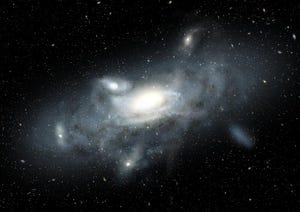
Distant Galaxy Dubbed the 'Sparkler' Mirrors Early Milky Way - CNET
NASA’s James Webb Space Telescope has glanced deep into the cosmos and found a distant galaxy that reminds astronomers of how our own Milky Way likely appeared when it was still a young and hungry galaxy on the block.
The as-yet unnamed galaxy looks to be about 9 billion light-years away and was found in early release data from Webb. It’s been nicknamed the “Sparkler” due to the two dozen bright globular clusters, each containing about a million densely packed stars, that orbit its center.
Much like our own galaxy in its youth, the Sparkler appears to be swallowing the clusters and satellite galaxies as it grows.
“We appear to be witnessing, first hand, the assembly of this galaxy as it builds up its mass,” explains Duncan Forbes, a professor of astronomy at Swinburne University in Australia.
Forbes is co-author of a paper about the Sparkler in the March issue of Monthly Notices of the Royal Astronomical Society.
The galaxy can be found in the direction of the constellation Volans, the flying fish. Astronomers say it provides a window into an earlier era when the universe was just one third its present age.
“We are excited by this unique opportunity to study both the formation of globular clusters, and an infant Milky Way,” Forbes said in a statement last week.
The Milky Way itself hosts around 200 globular clusters today, and they remain something of a mystery to scientists.
“We are thrilled that JWST can look back in time to see them in their youth,” adds co-author Aaron Romanowsky of San Jose State University.
The space observatory had a little assistance in its observations in the form of a gravitational lens and its lucky alignment in front of the Sparkler, essentially allowing Webb to take a deeper look into space.
The adolescent galaxy still has plenty of growing to do, according to the astronomers. It’s currently only 3% of the mass of the Milky Way but is expected to eventually expand to be just as large. The team hopes to take an even deeper look in the future to get a better idea of how long that might take and how many stars might have to be consumed in the process.


